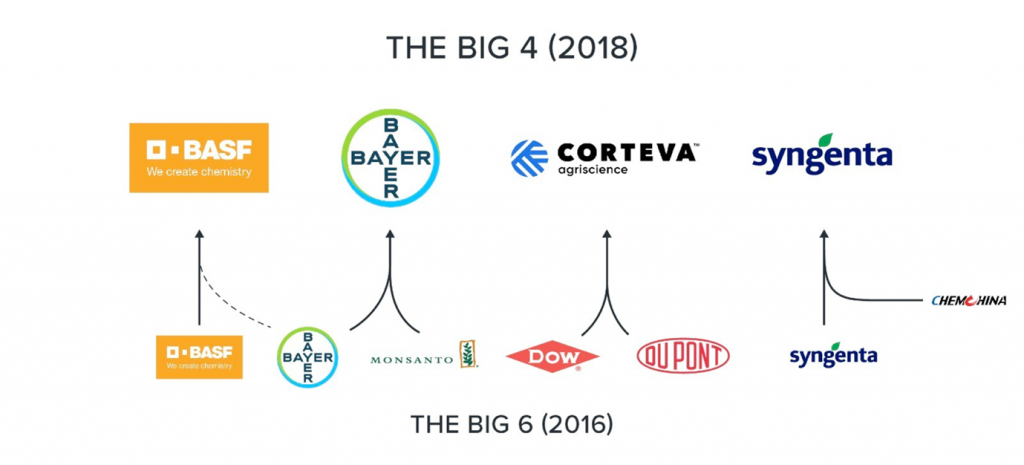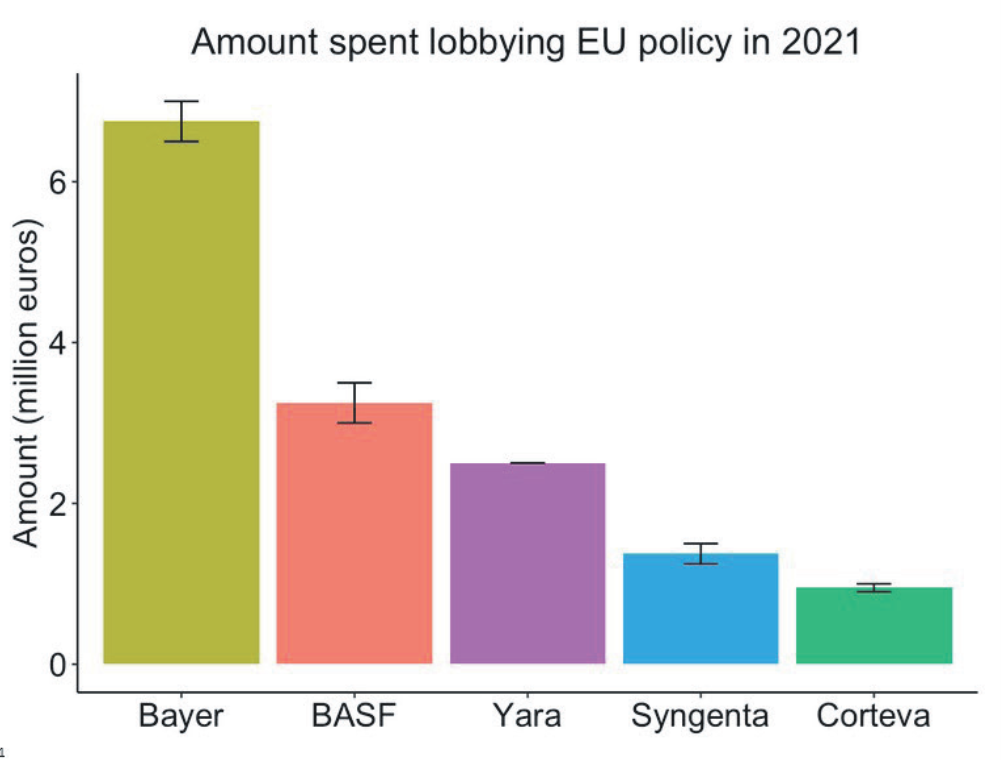We often hear about how “the Big 4” agrochemical and seed giants such as Bayer and Syngenta conduct research at WUR,
but there is little talk about the connection between our university and the key players in the fertilizer industry. This article
explains why the predominance of powerful multinationals at WUR is problematic, and scratches the surface of WUR’s ties
to the fertilizer industry.

To give you some background, the prominence of agribusinesses at WUR can highlight the omnipresent ideology of technological optimism. The common belief at WUR and in our wider society is that we need technologies such as “improved” seeds, fertilisers, and agrichemicals to solve our food system’s problems. The optimism in technofixes seems to be a systemic attitude at WUR, led in part by our Rector Magnificus Arthur Mol who has been an important figure in developing the Ecological Modernisation Theory, which argues that economic growth can be the solution to environmental problems. This is realised through technological optimism, by which agribusinesses can be counted on through their technologies to help us and their business models survive. Naturally, they are enthusiastic proponents of technofixes and ecological modernisation.
The resulting cosy relationship between WUR and large agribusinesses is however questionable because it maintains the asymmetric power of these companies in the market. This agrochemical and seed market is increasingly dominated by only a few companies that have a significant market share and thus exert a disproportionate influence on prices – a system known as an oligopoly. In the last several years, the market share of a small number of agribusiness companies has grown, partly led by the rise of gigantic mergers: what used to be called the industry’s “Big 6” has by now been reduced to the “Big 4”. The Big 4 and their subsidiaries show up in many places at WUR. One example is WUR’s Laboratory of Plant Breeding’s EUCARPIA Biometrics project, whose “regular sponsors” include Bayer, DuPont (now part of Corteva), and Syngenta, while Premium sponsors include Monsanto (now part of Bayer). WUR claims that EUCARPIA’s meetings “[provide] great opportunities to talk to leading experts”. What WUR fails to mention here is how these same agribusinesses have been complicit in humanitarian and environmental crimes.

Fertilisers are not entirely separate from the Big 4, some of these companies also produce fertilisers and have connections with fertiliser groups. The fertiliser industry is made up of a larger and more varied set of companies, but just like with the Big 4, certain groups still have a disproportionate amount of power. One of those is the International Fertiliser Association (IFA) which claims to be “the only global fertiliser association”. Its members account for 70% of the world’s production of mineral fertilisers, which are fertilisers composed of inorganic human-made compounds, the production of which emits greenhouse gases, uses fossil fuels, and requires rock mining. Members of the IFA include Koch Fertilizer, SinoFert, BASF, Yara, and Sabic (a fertiliser firm controlled by the Saudi state-owned fossil fuel company Saudi Aramco). Yara is Europe’s biggest industrial buyer of natural gas, and actively lobbies for fracking; they were also involved in one of Norway’s largest scandals in corruption. One way the IFA, and other groups in the fertiliser oligopoly, influence the food system is through lobbying policy. In the EU, the Norwegian fertiliser giant Yara is the biggest fertiliser lobby group, ranking 62nd biggest lobby group in the EU in 2021. This is a strategy that the Big 4 have had much practice in: Bayer was the 8th largest group lobbying EU policy in 2021.
Although not as widely criticised as WUR’s links with the Big 4, there seems to be a similar level of cosiness between the big players in the fertiliser industry and WUR. The IFA has invited WUR researchers to speak at their events and endorse their fertilisers. At an event in February 2019, a WUR researcher from Plant Production Systems attended a meeting exploring “environmental stewardship, climate change and innovation” in Rome. This WUR agronomist taught me last year in the course “Carbon Dilemma” and at this event spoke about the “scientific insights into […] fertiliser use and carbon sequestration”, showing the potential for carbon sequestration using fertilisers. Just a month later, in March 2019, another IFA event had a speaker from WUR, who spoke about the importance of addressing soil pollution “through innovative solutions”.

Apart from speaking at IFA events, WUR’s researchers have also collaborated in research with the IFA. There was a study in 2022 estimating maize harvest index and nitrogen use and WUR researchers worked in “close collaboration” with the IFA to create their Global Nutrient Use Database and Open Crop Nutrient Platform. Then there’s WUR’s Centre for Development Innovation (CDI), which has worked with the International Fertiliser Development Centre (IFDC) on multiple occasions. In 2013, a project carried out by WUR’s CDI with the IFDC aimed to “stimulate cooperation and innovation in policies and programmes in the African seed sector”. A year later, a project by the CDI for the IFDC looked to improve Northern Ghanaian value chains of maize, soya, and rice. The CDI also distributed and published two separate reports with the IFDC: one is a guide on how to become a seed entrepreneur, and another is a calculation manual on estimating costs for food production.
WUR was also a partner in the Global Yield Gap Atlas (GYGA), an online global agronomic database for the yield gap and potential of “key crops”. The GYGA claims to offer this data to “optimise yield productivity and resource use efficiency”. Sounds OK so far, but the GYGA relies on sponsorships to cover costs. Two of the Platinum sponsors of the GYGA are Yara and the IFA. When Yara became their first Platinum sponsor, WUR was “proud to announce” this news, reassuring us that “[the] Platinum sponsorship reflects the shared purpose by Yara to work towards a ‘climate positive food’ future through data-driven agronomy, products and solutions”. Apart from the Platinum sponsors, the GYGA also has some Silver sponsors, including Bayer – whose brand, WUR claims, “is synonymous with trust, reliability and quality worldwide”.
The need to collaborate with these agribusinesses runs deep for the chair groups whose existence relies on ties with agrichemicals and fertiliser companies. An example is WUR’s Laboratory of Phytopathology which studies plant diseases and how to control them, and they claim to “often collaborate” with industrial partners, including Yara and Syngenta.
Just like with the Big 4, the integrity of research in collaboration with fertiliser lobby groups is questionable. Arguably, there is always a potential conflict of interest in research. It is even designed into WUR’s research system since some researchers are required to get part (or all) of their funding from the private sector. Research is never objective, and biases are inevitable. When research is carried out for and with powerful lobby groups, it may be especially tempting to allow commercial interests to dominate the research outcome to ensure future funding. By doing so, WUR risks damaging its reputation and decreasing the reliability of its research. WUR’s collaboration with these influential lobby groups is also a slippery slope into greenwashing. These collaborations promote the legitimacy of these groups – presenting them as beneficial and necessary – and reinforce the ever-increasing power imbalance in our food system.
By Brigitte Wear
